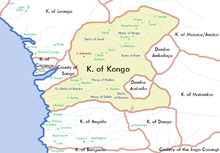|
Mbwila Rebellion of 1691–1693
The Mbwila Rebellion of 1691–1693 was a conflict between the Ndembu forces of Mbwila, led by Sebastião Afonso, and Portuguese colonial authorities from 1691 to 1693 in Angola. The rebellion saw early Ndembu successes before being suppressed by a Portuguese counteroffensive, which devastated the region and reasserted Portuguese control. BackgroundIn the late 17th century, the Kingdom of Kongo was weakening due to internal divisions and the growing influence of Portuguese colonial power in Angola. Mbwila, a province within Kongo, was traditionally a vassal of the Portuguese, but tensions began to rise as Portuguese expansionism clashed with the independence movements in the region.[1] RebellionExpulsion of the Portuguese, 1691By 1691, Sebastião Afonso, the ruler of Mbwila, declared his allegiance to Congo and Queen Njinga of Matamba, distancing himself from Portuguese rule. Sebastião expelled the Portuguese captain-major and chaplain, who had been stationed in Mbwila, he burned a church and blocked trading routes.[2][3][4] First battle, 1691The Portuguese organized a campaign to crush the rebellion. A force of 800 gunmen and 40,000 archers, composed of Portuguese soldiers and their African allies, invaded Mbwila.[3] They sacked local villages and attempted to subdue the region.[3] However, the rebels survived, and despite the initial strength of the Portuguese force, heavy rains and the outbreak of tropical diseases weakened the Portuguese, suffering significant losses, along with the commander while they were camped in Camolemba.[3][5] Second battle, 1692–1693By 1692/1693, the Portuguese regrouped and launched a counteroffensive under Pascoal Rodrigues.[5] The Portuguese attacked with overwhelming force, devastating the region. By 1693, the Portuguese had defeated the rebellion, forcing Mbwila back into submission and reestablishing its vassalage to Portugal.[2] AftermathThe Portuguese forces, after crushing the Mbwila rebellion, forced the Ndembu to renew their vassalage to Portugal.[2] References
Works cited
|
||||||||||||||||||||||||||||
